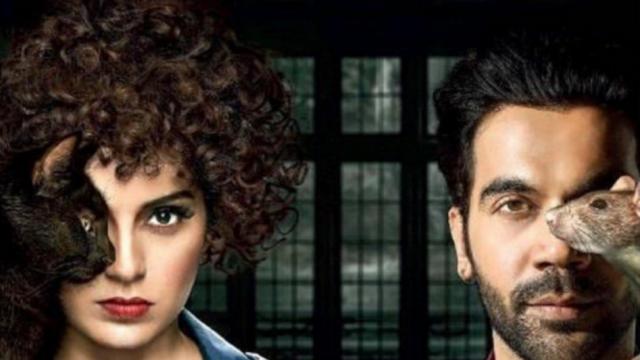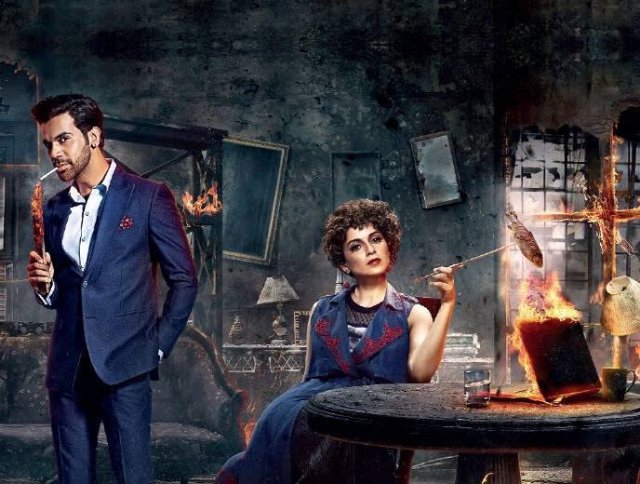Judgementall Hai Kya is bit of a jack of all trades kinda movie. It is a whodunit and a thriller and it loves to show off its psychedelic inspired takes on mental health. Unfortunately Prakash Kovelmudi is unable to pull off most of what he set out to do, even though the two protagonists played by Kangana Ranaut and Rajkummar Rao do put in credible performances.

The movie was earlier called “Mental Hai Kya?” but was later altered, after the Central Board of Film Certification (CBFC) criticised it as a “little harsh”. The former title was thought to be derogatory towards people with mental illness. It was also criticised by the Indian Psychiatric Society for being “stigmatising and degrading” towards mental disorders. They sent a letter to CFBC saying, “We take serious objections to the title of the movie which is discriminative, stigmatising, degrading and inhuman in projecting mental disorders and persons who suffer from mental disorders.”
Judgementall Hai Kya dazzles in bits, it has a kind of splendour. But, by the time we get to the unraveling of the climax, it gets wearying, delivered like hammer blows to your eyes and ear drums. The innovative use of sound and the imaginative visuals get tiresome as the script falls flat. The narrative does not hold. Intricately linking pretty threads together do not always produce a beautiful tissue. The threads hang limp, scattered all over the place.
Judgementall Hai Kya dazzles in bits, it has a kind of splendour. But, by the time we get to the unraveling of the climax, it gets wearying, delivered like hammer blows to your eyes and ear drums.
Right at the outset Bobby (the protagonist played by Kangana Ranaut) is set up as a narrator who cannot be relied upon. Indeed the red herrings strewn all over the story-line are obvious to an adept thriller watcher, and Bobby’s unreliability is put to good use here. Manipulation, most fine.
What is “normal” and who do we we accept as “people like us”? How far are we willing to go to accept differences?—are questions raised by this movie. In India and in Bollywood, there has been some talk on how mental illness has become more acceptable, with Deepika Padukone, the actress of her generation having disclosed her struggles with depression. In the west, and the US, a motley crew of therapists on Instagram have gone mainstream. Whilst the culture of awareness grows, real acceptance still seems way beyond the horizon.
People with real mental health issues are struggling to get treatment, because of the stigma with words like ‘MENTAL’, ‘PSYCHO’. It is highly insensitive to have title like #MentalHaiKya I humbly request to change the title @RajkummarRao #KanganaRanaut
— Dr. Pavan Sonar ?? (@PavanSonar) April 17, 2019
The legend of Sita, in a modern interpretation of the Ramayan is used in the second half of this movie to staggering visual effect, as extravagantly costumed creatures from the myth, walk around the streets of London. A surfeit of rainbow-hued graffiti in eye popping colours serves as a backdrop, making for a psychedelic effect and the word that springs to mind is “unhinged”. Bobby’s lucidity, already straining thin, now comes undone, in a grotesque culmination.These threads used to illustrate the “insanity” of the protagonist are good enough by themselves.
The protagonist does end up being a “hero”, but her idiosyncrasies are such that it’s difficult to imagine transferring this acceptance to the everyday for us—the viewers.
Perhaps you would say that this is only art, or that it is not the job of commercial cinema to educate. That conversation is for another day, yet we would all agree that representation matters. Intersectionality is all about giving a voice and a face to the under represented. And as the acceptance of mental illness expands to an extent, we are also faced with the question, what is reality, and what is normal? Even when we know we ought to seek help, our fear of being judged keeps us from it. As in life, so at the movies.
Even when we know we ought to seek help, our fear of being judged keeps us from it. As in life, so at the movies.
The alert viewer and the whodunit connoisseur would be aware of the use of mental illness as a prop. It is evident where the script and even the screenplay have been totally “inspired” by British crime dramas and of course Hollywood, which continues to “inspire” our cinema.
Here s why we need to #Bridgethegap in all aspects with regards to #Mentalhealth scenario in India. upcoming movie #mentalhaikya -the name, the images super triggering and loaded with stigma @netshrink @AnantBhan @chibberratna @VijayNallawala @mentalhealthind @healthcollectif . pic.twitter.com/DHGhfUF2CN
— Smriti Joshi (@SmritiSawhney) April 17, 2019
Some of the twists are totally inexplicable. How does Bobby suddenly turn up at her cousin’s place in London and how does she fund the trip? How does a dubbing artist suddenly get accepted by a theatre company and lands a plum role?
That said, Kangana Ranaut is in her element. Her performance shines through in most of the scenes. Her hysteria feels credible, though the diagnosis and its manifestations seemed too glib. The childhood trauma that Bobby suffers has an indelible impression on her. The theatrical, almost unreal enactment of the scene of the trauma felt jarring. It seemed to minimize the horror of the assault. I imagine it as a deliberate ploy, to make it all look unreal, to depict her craziness as merely fanciful.
Also read: Normalised Domestic Abuse And Stigmatised Mental Illness In My Family
Imperceptible erasure of reality and the gas lighting is something women are so used to experiencing. We are told again and again, we are “too sensitive” and that we “can’t take a joke” when the joke is at our expense. When we try to talk about abusive husbands, partners, we are told ‘but he’s a good guy’, as if our own lived experiences don’t matter. The adage of adding women and stirring, is not a recipe for bringing gender sensitivity to a script, is well illustrated in Judgementall Hai Kya. Script writer Kanika Dhillon chooses to undermine the narrative of a woman with such a trauma, so that fair representation remains remote.
Any woman’s rights activist will tell you that far more women die at the hands of their husbands and partners, yet Bobby’s fascination with domestic violence is depicted as almost quirky. She is shown making origami with scraps cut out of newspapers, all of which are reports of violent attacks by men. The relative tenderness of the narration towards Bobby is just about balanced by the mystery of Raghav, played by Rajkumar Rao.
On the one hand, the narrative seeks to undermine Bobby the narrator, yet it is also indulgent. But as the narrative turns out, why isn’t the trauma the other characters honored similarly?
“Tumhara trauma trauma hai, mera trauma gaya tel lene (Your trauma is justified, what about my trauma?)”
Also read: Generation Aami Offers An Empathetic Portrayal Of Mental Illness
Disjointed and patchy, and overly too long even at its short running time of just about 2 hours, I would still recommend Judgementall Hai Kya as a one time watch. While we make do with what we have, we keep demanding for better.
Featured Image Source: UrbanAsian
About the author(s)
A teacher by profession, a student of women's and gender studies, a life long learner and passionate feminist. Come, let me tell you why we should all be feminists!




